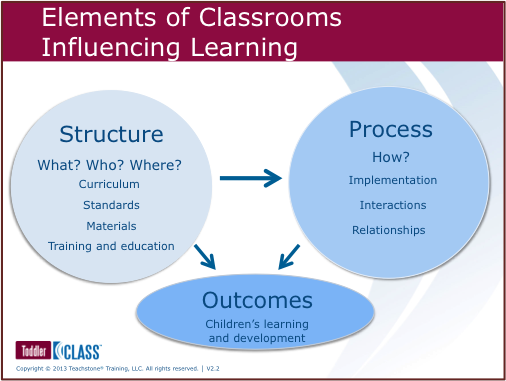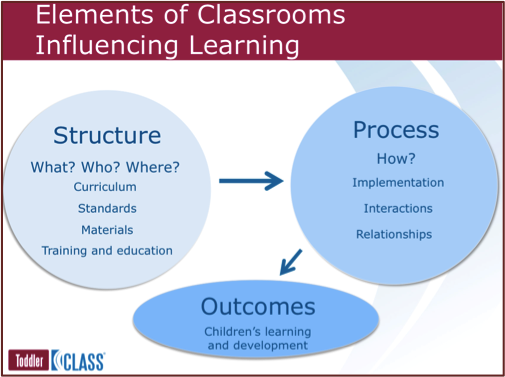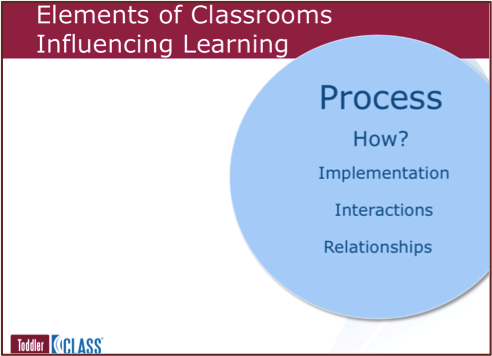
Supporting participants in shifting their lenses from structure to process is an on-going task throughout the 2-day observation training; it is a challenge I really enjoy as a staff trainer. Structure, mainly represented in environmental rating scales, but also in curriculum implementation checklists, health and safety checklists, and supplemental approaches (such as social-emotional curriculums) maintains a large presence in early childhood programs. The CLASS focus on process, and specifically on teacher-child and child-child interactions, is often a challenging switch for participants. As trainers, it is essential to guide participants in making this lens change, as it is a component that can hold many of them back from becoming reliable observers.
The great news: there is a structure (!) in place to guide your efforts—the observation training PowerPoint. Well, that and a few tips from your staff trainers, so read on!
The first opportunity to start the ‘tug’ to process really begins with the “Structure vs. Process” slide:

What you say here sets you and the participants up for success for the next couple of days while in training. It helps to review publications that stress the importance of process. One of my favorites (though there are many, including DAP by NAEYC, Third Edition, 2009) is Investing in Our Future: The Evidence Base on Preschool Education (2013). It states, on page 6, that:
- Process quality features
Refers to children’s immediate experience of positive and stimulating interactions—are the most important contributors to children’s gains in language, literacy, mathematics and social skills. - Structural features of quality
Refers to those features of quality that can be changed by structuring the setting differently or putting different requirements for staff in place, like group size, ratio, and teacher qualifications) help to create the conditions for positive process quality, but do not ensure that it will occur.
This information helps me frame how I talk through this slide with participants. As I click through the animation of the slide, I first...

Introduce “Structure” and “Process” (each bubble will click individually), and I explain/define what those two characteristics are (use your presenter notes to support you here)...then CLICK:

Now you have the “Outcomes” bubble. I say “Both are important in Toddler classrooms, and affect children’s outcomes, but let’s consider a couple of things...” then...CLICK:

Now you have the arrow pointing from Structure to Process. I say this: “Let’s think of “Structure” as a car, loaded with all the latest and greatest safety features, and “Process” as the driver (I then kind of describe safety features as well as how I could, as the driver, ignore or override all those safety features)...turns out my latest/greatest car is still only as safe as me the driver! It is like comparing the curriculum and the teacher. A program could have the best curriculum, with a fully stocked classroom, but the child’s experience is still dependent upon the teacher’s effective implementation of the curriculum, within the context of relationships...” then...CLICK:

Now “Process” has become a rather giant ball! It’s a bit dramatic, and also pretty fun! Here, I say, “So Process—the implementation, interactions, and relationships, are, as I like to say, number 1 most important to children’s learning and development, and are also the (notice my citation here from up above) most important contributors to children’s gains in language, literacy, mathematics and social skills. And the CLASS tool will focus on and measure those interactions.” Then, if you like, you may conduct a pretend mic-drop right here! Okay, I’m kidding just a bit, but I have done that at least once with a particularly fun (and already mostly experienced in CLASS) group.
I hope you have picked up some new ideas (or thought of a few of your own while you were reading!) for presenting this all-important, first step in supporting your participants as they learn to separate “Structure” from “Process.” Stay tuned for Part 2, where will discuss using the next few slides of the observation PPT to continue the process of focusing on “Process!”
- Yoshikawa, H., Weiland, C., Brooks-Gunn, J., Burchinal, M. R., Espinoza, L. M., Gormley, W. T., Ludwig, J., Magnuson, K. A., Phillips, D., & Zaslow, M. J. (2013). Investing in our future: The evidence base on preschool education. New York, NY: Foundation for Child Development.
- http://fpg.unc.edu/node/6419

